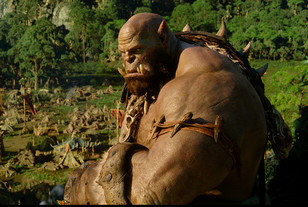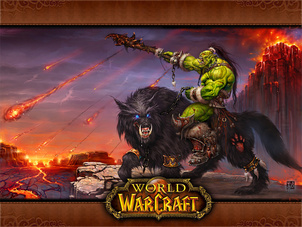Written by Mike Cervantes Warcraft hits theaters on June 10th, the feature film milestone based on Blizzard’s hit video game franchise, spanning as far back as 1994. The film has already partaken in a vast amount of pre-screenings, and, no surprise, the reviews have been pretty rotten. The main criticism is that the two- hour runtime of the film boils down the full book of Warcraft lore into what appears to be a pretty by the numbers fantasy flick, made to be taken slightly less serious by the ever-presence of the CG, motion-captured orcs. These orcs, made to exactly resemble the orcs of the video game series are just big, glossy, leathery beings with sloped foreheads, speaking erudite English through pairs of protruding lower tusks, supposedly breaking the realism…of a complete and utter fantasy film. The general issue I have with most pre-screening reviews is that the film critics, internet movie buffs notwithstanding, often look at what is presented as a film as its own, and overlook the subtle nuances presented by a franchise film, which already has a lore and history that is well known and appreciated by long-time consumer media geeks like us. But the criticism of Warcraft’s orcs somehow seemed especially unfair, because as a fantasy franchise, the Warcraft series has elevated the concept of the orc much higher than any fantasy concept that ever came before it. How do you ask? Well, that requires a bit of literary exploration. The creature that we call “orc” originated in the lore of J.R.R. Tolkien, and his iconic series of Middle Earth adventures, the word “orc” deriving from the latin “Orcus” meaning, “creature of the underworld, from which we also derive the root of the established “Ogre.” Orcs have always occupied a middle-ground in terms of marginally intelligent humanoid fantasy monsters, always falling somewhere between mountainous Ogres and small, pesky goblins. In terms of capability, they are described as being large, muscular, frequently green-skinned, though not-as-often scaly or reptilian. Tolkien described them as being fanged, wide-mouthed, and flat-eyed, while the earliest D&D modules gave them literal pig-faces with boar tusks. In terms of personality, orcs are often described as slow-witted, quick to anger and violence, and favored to primitive and taboo practices like cannibalism. Already with this description certain sociological alarm bells tend to go off in our heads in regards to what we’re being told. To both Tolkien and Gygax, the orc was created for the sole purpose of having a fictional societal other, a being that immediately appears to be behind our social standing, and therefore, appropriate to stab with a sword and fill with arrows. Of course, in both fantasy fiction and role playing games there are plenty of other creatures that exist for the same purpose: goblins, troglodytes, and so on. There are also plenty of perfectly evil human beings running around. But given that the orc was invented solely to populate the armies of Middle Earth’s demonic entity Sauron, and in D&D they’re made to serve…as a simple battle to gain XP and possibly gold. These early interpretations seem too easy and too facilitating to the detriment of the orc, that we have a tendency to think that this is propaganda. There has to be more to a thriving society of people than that. And so our geeky forefathers began to embark upon what might have been the very first anthropological elevation of a fictional fantasy monster. This was most easily seen in further modules of the D&D role-playing game. Without the fear of differentiating itself from its Tolkien-based source material, the pig-faced orc vanished in favor of a form more akin to Tolkien’s descriptions. In time orc villages and civilizations began popping up in campaigns, although they were still violent and off limits to the player characters. It wasn’t until the 2nd edition of Advanced Dungeons and Dragons, that we got the first playable character orc modules.  As a player character, the orc is “suggested” to be in the role of a fighter, barbarian, or monk, with their alignments always skewing to the neutral, evil and chaotic, illustrating that our initial perceptions of the wicked dullard were not burned out of the race, even though it was likely that individuals playing their own orc characterized them in any way they pleased. As our perceptions of player creations became more general over time, it became common to see orc clerics, that is, orcs that had actual religion, along with any orc class under the sun. Many descriptions of the “enlightened orc” suggest a lone rogue orc came in contact with human society, and was able to be given a sense of education and civilization. There was still one key component missing in the societal acceptance of the orc, and that was the acknowledgement that orc society as it stood could not be as heinously savage and standard-bearing evil as it was first interpreted. This is where Warcraft comes in. In its earliest iterations, Warcraft was a real time strategy game, pitting the standard side of the fantasy pantheon containing humans, dwarves, and gnomes, collectively called “The Alliance,” against the goblins, ogres, and orcs, called “The Horde.” What Warcraft did that its fantasy forefathers hadn’t done before, was put you in command of an entire army of the types of monsters you usually slain in a standard D&D game. The orcs, as always, stood in the center of the whole melee, and as you played, you couldn’t help but be charmed as members of your orc battalion whimpered “yes master,” as you commanded them, whined “nope, too hungry” when resources were depleted, and even “*belch* ‘scuse me…” whenever they were left idle. The need to interpret an orc army into a set of playable characters made the orc seem relatively human for the very first time. As the lore expanded in World of Warcraft, we got a glimpse into the inner workings of The Horde as a whole. The player became immersed, walking among the villages and pavilions of many societies, the orc among them. We began to see orcs as members of pre-modern society, living in grass huts alongside shamans and priests, who hunt, farm and raise families. We learned the names of their leaders, the standards of their way of life, and we were introduced to famous orcs like Thrall and Garrosh, who were destined to make up the cornerstones of a movie based on Warcraft if one were ever made. Sure, they were still angry, and they were still war-like, but you would be too if you happened to be seen as a monster, living on the other side of a line drawn between the ugly and cute beings of the planet. They don’t live with the intrinsic need to be mean. It is ultimately society which does these things to us. Our ability to see the orc as a diverse race with qualities not unlike our own was an inevitability. After all, objects of fantasy worlds tend to come out of our own imaginations. Once we became of diverse minds, it simply became less and less reasonable to think that beings capable of any level of civilization were limited to mere hate, even if the entire purpose of their creation was created in fiction to do exactly that. Which leaves us all with the simplest lesson the orc can treat your standard-wash film critic about prejudice: we only resent how the orcs look, based on what is on the outside. What Blizzard entertainment has shown us in over two decades of Warcraft is that there is much more to a human conflict than can be illustrated to us merely by using humans. When Warcraft finally does release on June 10th, I’ll be happy to see what the film does in furthering my opinion of this fascinating fictional race.
0 Comments
Leave a Reply. |
Archives
March 2025
|
|
© 2012-2025, Nerds That Geek LLC.
All Rights Reserved. |
uWeb Hosting by FatCow


 RSS Feed
RSS Feed